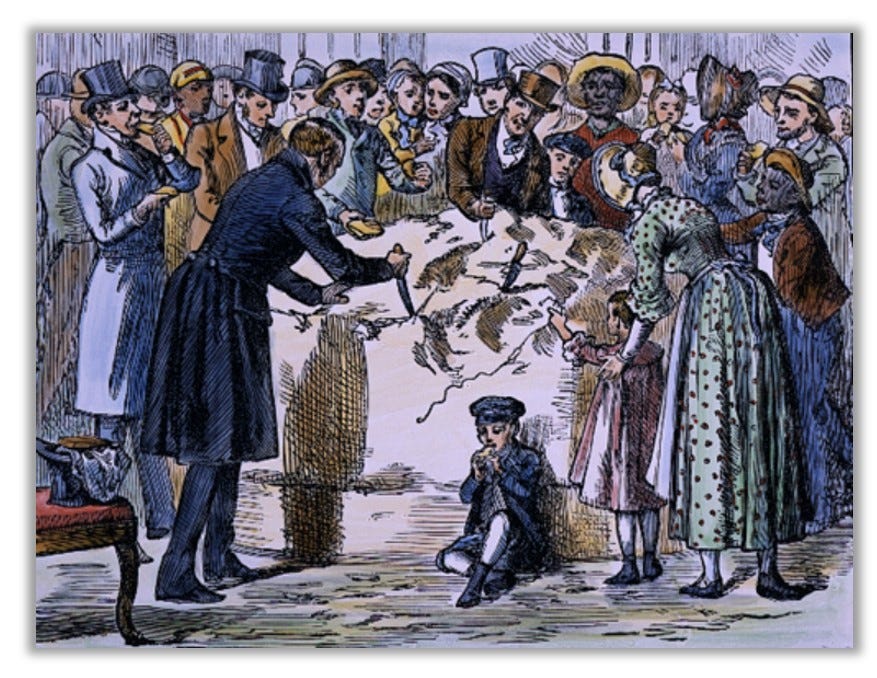TDIH: Jefferson's "Mammoth Cheese"
The unusual gift came on the heels of a hotly contested election.
On this day in 1802, Thomas Jefferson makes a $200 payment for a surprising reason. Do you know about the “mammoth cheese” that he received from supporters when he was first elected President? The cheese weighed 1,235 pounds!
Surely he was surprised to receive a massive block of cheese as a token of support?
The unusual gift came on the heels of a hotly contested election: The main contenders in 1800 were supposed to be John Adams and Thomas Jefferson, but the election had an unexpected twist: The Electoral College ended in a tie between Jefferson and his running mate, Aaron Burr. In such a situation, the House of Representatives gets to choose the President.
This back-up election process proved messy, although Jefferson ultimately prevailed after 36 ballots.
Needless to say, Jefferson’s supporters were overjoyed by the outcome. Parades were held. Celebratory cannons were fired. Local groups wrote and mailed letters of congratulations to their new President. Yet the town of Cheshire, Massachusetts, wanted to do something even more grand. At the prompting of Elder John Leland, a Baptist, they decided to make a massive block of cheese.

That cheese was made from the milk of 900 cows. (Reportedly, the milk of Federalist cows was refused.) Once it was done, it was inscribed with Jefferson’s personal motto: “Rebellion to tyrants is obedience to God.”
Making the cheese was one thing, but transporting it to D.C. was even harder. Much of that difficult journey was made on the Hudson River or other bodies of water, but the final leg of the trip was made “in a wagon drawn by six horses,” according to one news report.
By then, the enormous cheese had gripped the interest of the nation.
“Republican editors portrayed the cheese as a sincere and selfless token of affection for the president and an admirable example of republican labor and ingenuity,” the editors of The Papers of Thomas Jefferson conclude. “Federalists ridiculed it as a ludicrous example of democratic excess and Jeffersonian idolatry.”
In fact, Federalists attached the name “mammoth” to the cheese in an attempt to mock the gift. The move backfired. The label “mammoth cheese” simply endeared it to Jefferson’s supporters.
Either way, the cheese arrived in D.C. at the end of December 1801, and it was presented to the President on New Year’s Day 1802. Leland praised Jefferson, but he also took time to note that the cheese “was produced by the personal labor of Freeborn Farmers, with the voluntary and cheerful aid of their wives and daughters, without the assistance of a single slave.”
A few days later, Jefferson paid Leland $200 for the cheese because he had a policy of not accepting gifts while in office.
The cheese lasted longer than you might think. It was moved to the East Room of the White House where it stayed for years. It was apparently served at Independence Day celebrations in 1802 and 1803. It may still have been around in early 1804, possibly filled with maggots. A contemporary described the cheese at that juncture: It was “very far from being good.”
Legend has it that the last of the cheese was eventually dumped in the Potomac River.
Even funnier? Jefferson was not the last President to receive such a massive block of cheese. A few years later, Andrew Jackson got an even bigger one. His cheese weighed in at 1,400 pounds.
Our history has such unexpected twists and turns, doesn’t it?
Sources can always be found on my website, here.




That’s such a cheesy story. ;)
Unexpected twists and turns in our history indeed! This was an interesting piece of American history. Two things especially stood out to me in this account. Jefferson’s statement: “Rebellion to tyrants is obedience to God.” The other is that Jefferson paid Leland $200 for the cheese because he had a policy of not accepting gifts while in office. Remarkable integrity! Sadly lacking in today’s politicians. Another excellent history lesson. Tara.